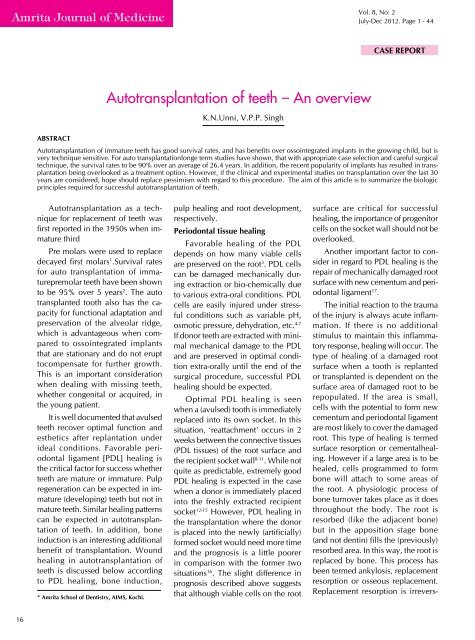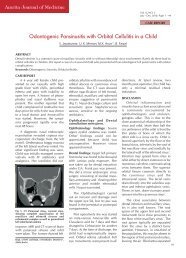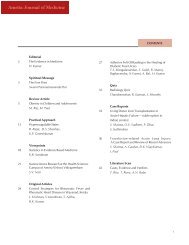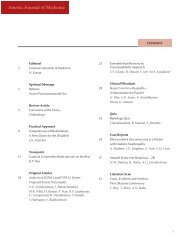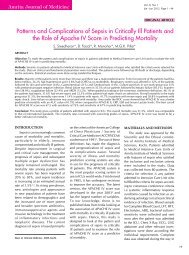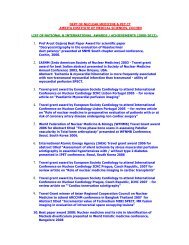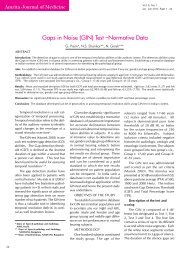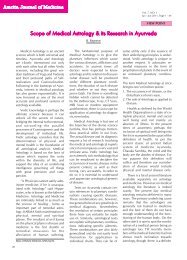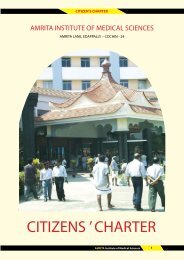Autotransplantation of teeth â An overview
Autotransplantation of teeth â An overview
Autotransplantation of teeth â An overview
You also want an ePaper? Increase the reach of your titles
YUMPU automatically turns print PDFs into web optimized ePapers that Google loves.
Amrita Journal <strong>of</strong> Medicineroots, or single but concave or enlarged root, because<strong>of</strong> the potential for fracture at extraction or mechanicaldamage to the PDL because <strong>of</strong> a difficult extraction.Follow-up resultsReported survival rates <strong>of</strong> autotransplantation varyfrom 74–100% 33 . The follow-up periods and the kinds<strong>of</strong> <strong>teeth</strong> transplanted are different in each study. Severalfactors would affect the results <strong>of</strong> autotransplantation.The author has performed over 250 conventionalautotransplantations <strong>of</strong> <strong>teeth</strong> in 15 years. Of those, mostwere done with fully developed <strong>teeth</strong>; about 20 casesinvolved developing <strong>teeth</strong>. A total <strong>of</strong> 220 consecutivecases, which were observed for more than 2 years, wereanalyzed. The average follow-up period is about 6 years.The survival rate is in the range <strong>of</strong> 90% and success rate82%. The survival rate <strong>of</strong> the transplants into extractedsockets is 100% and their success rate is 95%. The survivaland success rate <strong>of</strong> intra-alveolar transplantationare high as well. On the contrary, the survival rate <strong>of</strong>the transplants into artificially formed sockets is about75% and their success rate is 60%. The decrease insuccess for transplants into artificial sockets mirrors thehistological results <strong>of</strong> a study in monkeys and appearsto highlight the importance <strong>of</strong> the periodontal ligamentcells remaining on the socket wall after extraction 34 .<strong>An</strong>other reason may be the increased extra-oral timewhen forming a large recipient socket into a compactbone which is time consuming and increased PDL damagedue to socket adjustment and occlusal adjustmentthat is more difficult in these cases. However, as withall procedures, the younger the patient the higher thesuccess rate. It is nearly 90% if patients are youngerthan 40 years <strong>of</strong> age 35 .Comparison <strong>of</strong> dental implant and autotransplantation<strong>of</strong> <strong>teeth</strong>It is inevitable to compare transplants with implantsbecause the two techniques have similar purposes.So, the criteria for choosing each must be discussed.Implants are indicated to all patients (who can affordthem) while transplants are limited to those who haveappropriate donor <strong>teeth</strong> 36 . The techniques for transplantsand implants are similar in difficulty and so is the highprognosis. However, the post-surgical restorative optionsare generally much simpler for transplanted <strong>teeth</strong>.Studies shows, transplants would be chosen prior toimplants in the following cases:• Patients treated before pubertal growth: If osseointegratedimplants are placed in these patients, theydo not erupt along with adjacent <strong>teeth</strong> and result ininfraocclusion with functional and esthetic problems.Transplanted <strong>teeth</strong> erupt in harmony with the adjacent<strong>teeth</strong>. However, it should be emphasized that transplantationshould not be carried out too early, since atthis stage <strong>of</strong> root development, the prognosis is not aspredictable 37-41 .• When patients have an unrestorable tooth requiringextraction and an ideal donor tooth is present:Transplants have several advantages over implants interms <strong>of</strong> function, esthetics, time and cost. Immediatetransplantation with extraction at the recipient siteis a procedure that provides significant time savingcompared to implants. Healing is rapid and function isobtained almost immediately. The transplanted tooth hasosteoinducing properties that results in bone regeneration<strong>of</strong> the bony defects around transplants without graftmaterials, significantly reducing time and cost comparedto implants. Transplants have the potential for superioresthetic results, since the natural emergence pr<strong>of</strong>ileand the natural beauty <strong>of</strong> enamel and crown form ismaintained. Usually, the total cost <strong>of</strong> transplantation ismuch lower than implant treatment.• When intra-alveolar transplantation or intentionalreplantation is indicated: Severely decayed <strong>teeth</strong> andcrown-root fractured <strong>teeth</strong> can <strong>of</strong>ten be saved by surgicalextrusion 42-45 . In addition, intentional replantation is atreatment option for <strong>teeth</strong> with endodontic disease thatcannot be treated by conventional means. In clinicalpractice, it usually makes sense to maintain the use <strong>of</strong>natural <strong>teeth</strong> for as long as possible. With such proceduresavailable, extractions can be avoided or at leastdelayedConclusion<strong>Autotransplantation</strong> is <strong>of</strong>ten not considered as atreatment option when <strong>teeth</strong> are lost. This is very unfortunategiven that the biological principles for success areunderstood and the correct indications are present; it isan extremely successful treatment form with significantsavings in time and cost compared to implants. From thepatient’s perspective, the dentition is preserved using anatural tooth rather than a mechanical prosthesis. Thedental practitioner should definitely have the knowledgeto recommend and carry out this procedure to the appropriatepatient. <strong>Autotransplantation</strong> <strong>of</strong> <strong>teeth</strong> based onscience and the state <strong>of</strong> art will promise happiness andhealthy smiles <strong>of</strong> patients for a long time.References1. Apfel H. Autoplasty <strong>of</strong> enucleated prefunctional third molars.JOral Surg 1950;8:189–200.2. <strong>An</strong>dreason J, Paulsen H, Yu Z, Bayer T, Schwartz O. Alongtermstudy <strong>of</strong> 370 autotransplanted premolars. Part II.Tooth survival and pulp healing subsequent to transplantation.Eur JOrthod 1990;12:14–24.3. Lee S-J, Jung I-Y, Lee C-Y, Choi SY, Kum K-Y. Clinicalapplication<strong>of</strong> computer-aided rapid prototyping for toothtransplantion. Dent Traumatol 2001;17:114–9.20
Amrita Journal <strong>of</strong> Medicine<strong>Autotransplantation</strong> <strong>of</strong> <strong>teeth</strong> – <strong>An</strong> <strong>overview</strong>4. Roberts JA, Drage NA, Davies J, Thomas DW. Effective dosefromcone beam CT examinations in dentistry. Br J Radiol2009;82:35–40.5. <strong>An</strong>dreasen JO, Paulsen HU, Yu Z, Bayer T, Schwartz O.Along-term study <strong>of</strong> 370 autotransplanted premolars, Part II.Tooth survival and pulp healing subsequent to transplantation.EurJ Orthod 1990;12:14–24.6. Guerini V. A history <strong>of</strong> dentistry from the most ancient timesuntil the end <strong>of</strong> the eighteenth century. Philadelphia: Lea&Febiger; 1909, p. 280–336.3. Hunter J. The natural history <strong>of</strong> human <strong>teeth</strong>. London: J JJohnson; 1771.4. Cserepfalvi M. Clinical report <strong>of</strong> homotransplantations.J AmDent Assoc 1963;67: 35–40.5. Cserepfalvi M. Experimental homogenous transplantation <strong>of</strong>human <strong>teeth</strong> obtained from a human cadaver. J Oral ImplantTransplant Surg 1966;12: 66–726. Shulman LB. Allogenic tooth transplantation. J Oral Surg1972;30: 359–4087. Cserepfalvi MP. Homotransplantation <strong>of</strong> human <strong>teeth</strong> withand without pulp tissues. J District Colombia Dent Soc1976;11–5.8. Baum AT, Herts RS. Autogeneic and allogeneic tooth transplantsin treatment <strong>of</strong> malocclusion.Am J Orthod 1977;72:368–969. Schwartz O, Frederiksen K, Klausen B. Allotransplantation<strong>of</strong> human <strong>teeth</strong>. A retrospective study <strong>of</strong> 73 transplantationsover a period <strong>of</strong> 28 years.Int J Oral Maxill<strong>of</strong>acSurg 1987;16:285–301.10. Nordenram Å. Allogenic tooth transplantation with an observationtime <strong>of</strong> 16 years. Clinical report <strong>of</strong> 32 cases.SwedDent J 1982;6: 149–5611. Apfel H. Autoplasty <strong>of</strong> enucleated prefunctional third molars.J Oral Surg 1950;8: 289.12. Apfel H. Preliminary work in transplanting the third molarto the first molar position. J Am Dent Assoc 1954;48:13. Apfel H. Transplantation <strong>of</strong> the unerupted third molar tooth.Oral Surg 1956;9: 9614.14. Miller HM. Transplantation and replantation <strong>of</strong> <strong>teeth</strong>. OralSurg 1956;9: 84. Links15. Fukuro K. Bone morphometrical studies <strong>of</strong> intentional replantationin monkeys’ <strong>teeth</strong>.Jpn J Conserv Dent 1991;34:957–85[in Japanese].16. Ichinokawa H. Ultrastructural studies on periodontal tissuereactions following intentional tooth replantation in adultmonkeys. Jpn J Conserv Dent 1995;38: 63–8717. Ohyama K. The effect <strong>of</strong> storage media on periodontalhealing after intentional replantation <strong>of</strong> <strong>teeth</strong> in monkeys.Ahistopathological and morphometrical study.Jpn J ConservDent 1996;39: 685–70618 Isono T. Effect <strong>of</strong> storage media upon periodontal healingafter replantation <strong>of</strong> <strong>teeth</strong> in adult monkeys. J JpnSoc OralImplantol 1998;11: 375–8519 Löe H, Waerhaug J. Experimental replantation <strong>of</strong> <strong>teeth</strong> indogs and monkeys.Arch Oral Biol 1961;3: 176–84.20. Najleti CE, Caffesse RG, Castelli WA, Hoke JA. Healing aftertooth reimplantation in monkeys.A radioautographic study.Oral Surg 1975;39: 361–75. Links21. <strong>An</strong>dreasen JO. A time-related study <strong>of</strong> periodontal healing androot resorption activity after replatation <strong>of</strong> mature permanentincisors in monkeys.Swed Dent J 1980;4: 101–1022. Proye MP, Polson AM. Repair in different zones <strong>of</strong> the periodontiumafter tooth reimplantation. J Periodontol 1982;53:379–8923. Shimada T. Effect <strong>of</strong> periodontal ligament curetted in alveolarsocket for autotransplantation <strong>of</strong> tooth in adult monkeys. JJpnSoc Oral Implantol 1998;11: 492–500[in Japanese24. <strong>An</strong>dreasen JO. Periodontal healing after replantation andautotransplantation <strong>of</strong> incisors in monkeys.Int J Oral Surg1981;10: 54–61.25. <strong>An</strong>dreasen JO. <strong>An</strong>alysis <strong>of</strong> topography <strong>of</strong> surface and inflammatoryroot resorption after replantation <strong>of</strong> mature permanentincisors in monkeys.Swed Dent J 1980;4: 135–4426. <strong>An</strong>dreasen JO. <strong>An</strong>alysis <strong>of</strong> pathogenesis and topography<strong>of</strong> replacement resorption (ankylosis) after replantation <strong>of</strong>mature permanent incisors in monkeys.Swed Dent J 1980;4:231–4027. <strong>An</strong>dreasen JO. Relationship between cell damage in theperiodontal ligament after replantation and subsequent development<strong>of</strong> root resorption.ActaOdontolScand 1981;39:15–25.33.28. <strong>An</strong>dreasen JO, Kristerson L. The effect <strong>of</strong> limited drying orremoval <strong>of</strong> the periodontal ligament.Periodontal healing afterreplantation <strong>of</strong> mature incisors in monkeys.ActaOdontolScand1981;39: 1–13.[PubMed link]Links29. <strong>An</strong>dreasen JO, Skougaard MR. Reversibility <strong>of</strong> surgicallyinduced dental ankylosis in rats. Int J Oral Surg 1972;1:98–102.35.30. <strong>An</strong>dreasen JO. Histometric study <strong>of</strong> healing <strong>of</strong> periodontaltissues in rats after surgical injury. I. Design <strong>of</strong> a standardisedsurgical procedure. Odontol Revy 1976;27: 115–3032. <strong>An</strong>dreasen JO. Histometric study <strong>of</strong> healing <strong>of</strong> periodontaltissues in rats after a surgical injury.Healing events <strong>of</strong> alveolarbone, periodontal ligaments and cementum.Odontol Revy1976;27: 131–44.33. Yoshida M. <strong>An</strong> experimental study on regeneration <strong>of</strong>cementum, periodontal ligament and alveolar bone in theintradentinal cavities in dogs.The ShikwaGakuho 1976;76:1179–222[in Japanese].34 <strong>An</strong>dreasen JO. Review <strong>of</strong> root resorption systems and models.Etiology <strong>of</strong> root resorption and the homeostatic mechanisms<strong>of</strong> the periodontal ligament. In: The biological mechanisms<strong>of</strong> tooth eruption and root resorption. Birmingham, Alabama:EBSCO Media; 1988. 9–21.35. Atrizadeh F, Kennedy J, Zander H. <strong>An</strong>kylosis <strong>of</strong> <strong>teeth</strong> followingthermal injury. J Periodontal Res 1971;6: 159–6736 Cvek M, Lindvall A. External root resorption following21


